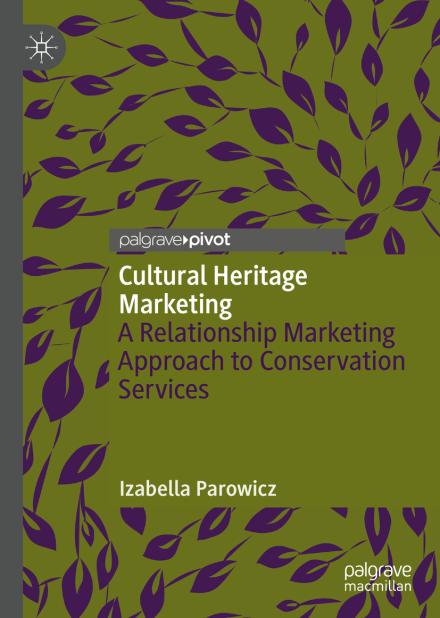Book Review: Cultural Heritage Marketing: A Relationship Marketing Approach to Conservation Services
Submitted by sharragrow on

Review by Julian Bickersteth
Cultural Heritage Marketing: A Relationship Marketing Approach to
Conservation Services
By Izabella Parowicz
Palgrave Macmillan, 2019
158 Pages / 44,02 € eBook / 57,19 € Hardcover
ISBN 978-3-030-00287-9 (eBook)
ISBN 978-3-030-00286-2 (Hardcover)
Finding books that are directly applicable to the business of private conservation is not an easy matter. So when Cultural Heritage Marketing: A Relationship Marketing Approach to Conservation Services came across my desk for review I fell upon it as a rare find. The publishers Palgrave Macmillan, part of the vast Springer Nature publishing group, note that they have a proud tradition of championing pioneering research in new or under represented areas, publishing an impressive 1,000 titles per year, and I guess private conservation fits that description.
So I was already feeling good about this book before I opened the cover, and I am glad to report that it does not disappoint. For any conservator seeking to market their own business, this should be high on the list of reference books, and for those already in business, read it if only to recognise the description of the realities of private conservation marketing. Whilst reading the book, I found myself a number of times nodding in agreement with the situations and outcomes described.
After an introduction the book is divided into five chapters, each touching upon particular aspects of the marketing of heritage conservation services. Chapter 2 is entitled Bringing marketing into heritage conservation services and includes an introduction to the concept of relationship marketing.
Chapter 3 looks at characteristics of heritage conservation services exploring the business encounter between providers and users of conservation services. It also looks at the nature of competitive advantage and weighs up the benefits of satisfying customer needs against the price of doing so.
Chapter 4 looks at the characteristics of users of conservation services and the buying decision process. This addresses customer uncertainties around the process of commissioning conservation work and also how word-of-mouth customer satisfaction and marketing more broadly can be maximised for the benefit of the business.
Chapter 5 focuses on the business itself and how the conservation service process can be designed and optimised from an organisational point of view.
And finally, chapter 6 summarises the issue of commercial versus social marketing, whereby commercial marketing is principally of a financial nature aimed at increasing the income of the provider whilst social marketing aims to influence the target audience to change their behaviour for the benefit of the provider.
The main premise of this book is that the financial success of conservators running their own business depends on their marketing skills including developing sustainable relationships with customers and continuously orientating themselves towards the needs and expectations of those customers.
Fundamental to this is an understanding around relationship marketing which is based upon building a relationship with the client as the underpinning of commercial success, rather than transactional marketing which is essentially about selling something for a service irrespective of any relationship around it. To quote the author, ‘Transactions lack history and memory and they don’t get sentimental”. Relationship marketing is shaped by personal communication, accessibility and responsiveness.
Behind all this is a wealth of research undertaken initially in Malta and then wider afield; the data was apparently collected from 484 conservators in 54 countries through an online survey. It is particularly focused on the individual customer rather than the corporate or government client, whereas most private conservators deal with a mix of both. But its value does lie in understanding the individual customer, and there is a particularly useful table which talks about the customer journey—what they may be thinking and feeling, what their pain points may be and, perhaps most usefully, what opportunities exist in that journey for the service provider.
As the product of a PhD dissertation, it is unnecessarily long; some of the book is perhaps overly analytical and the expansive bibliographies at the end of each chapter read far more like a thesis than a self-help book. But these are minor gripes when seen against the value this book will provide for private conservators worldwide as they seek to run a successful conservation business.
AUTHOR BYLINE
Julian Bickersteth is a private conservator who founded and has run International Conservation Services in Australia for the past 30 years. Julian is also actively involved in IIC, having chaired the local organising committee for the IIC Melbourne 2000 Congress, and served as Vice President and then the first Director of Communications. He was elected to his current post as IIC President in January 2019.